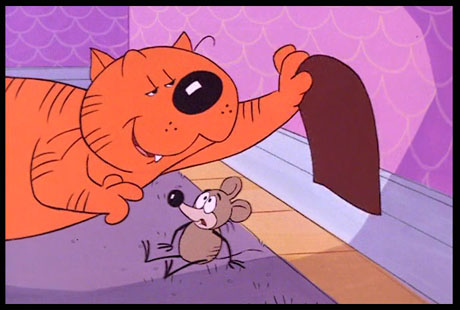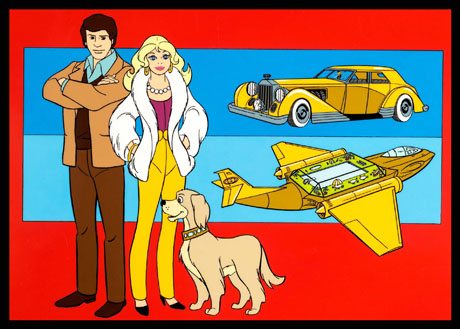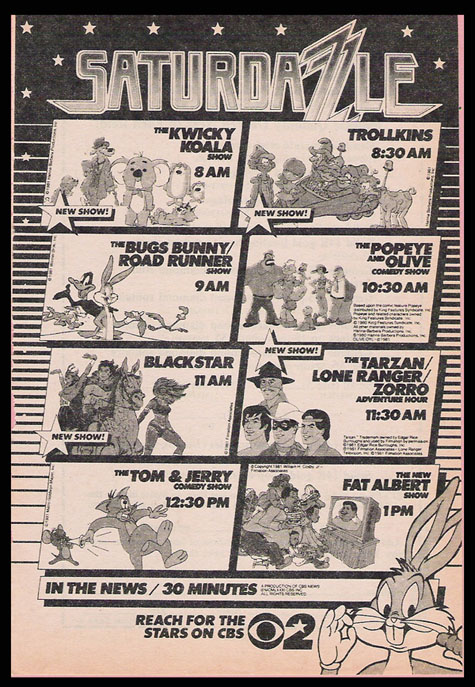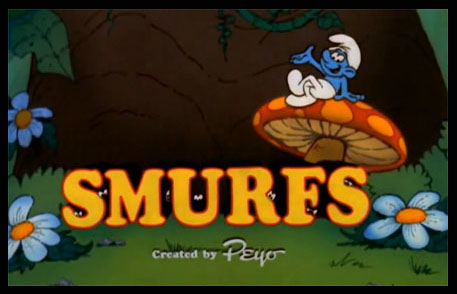Saturday mornings were a hallowed place for kids. For four to five hours, we had a respite from the weekly “grind” that the school week seemed to be. And, while our parents would dare to sleep in and we would avoid having to mow the lawn, we could pour ourselves a bowl of sugar that disguised itself as cereal and settle down in front of the TV. There, cartoon characters who had become like friends that would stop by each week, would return for a visit. Saturday morning cartoons were once a popular segment of television programming unto itself.
As we began a new decade of the eighties, these cartoons continued strongly after several decades of immense popularity. Now, in part two of a three-part article, here is a trip back in time forty years ago to “throwback” to the cartoons that debuted that season.

As we left a summer in which Indiana Jones ruled movie theaters in his first adventure with Raiders of the Lost Ark and Dallas reigned over the prime-time airwaves, here are the cartoons that premiered in September of 1981:
ABC
The newspaper comics-inspired ABC this season. Heathcliff, the trouble-making cat, had debuted with his show the year before (Heathcliffe and Dingbat) but partnered with another comic favorite for Heathcliff and Marmaduke in 1981. On the show, Heathcliff cartoons were alternated with those featuring the clumsy but well-meaning Great Dane, Marmaduke. Produced by Ruby-Spears, the show featured a wealth of veteran voice acting talent, including Mel Blanc, June Foray, Don Messick, Frank Welker, and Paul Winchell. As if that wasn’t enough, Scatman Crothers sang the show’s theme song.
Ruby-Spears also introduced Goldie Gold and Action Jack in 1981 on ABC. An animated take on such live-action prime-time shows as Charlie’s Angels and Hart to Hart, Goldie was one of the world’s richest women and an heiress who owned a newspaper. Jack was a reporter for the newspaper that she owned. The two, with Goldie’s dog, Nugget, would span the world looking for adventure.

There was exciting narration over the globe-trotting scenes in the show’s opening (“By land, by sea, by the seat of their pants!…”). Unfortunately, Goldie Gold and Action Jack’s adventures didn’t last the entire season, and sadly, the show was canceled in December.
Hanna-Barbera brought us Laverne & Shirley, in the Army, (also known simply as Laverne & Shirley) continuing a long-standing tradition of adapting prime-time series for Saturday morning animation. The year prior, ABC and Hanna-Barbera had success with the animated The Fonz and the Happy Days Gang, so bringing Laverne and Shirley into the Saturday morning fold was a no-brainer.
Penny Marshall and Cindy Williams provided the voices for their animated counterparts, and there were some very cartoony elements, including adventures with a UFO and their commander, Sgt. Squealy, who was a pig (you read that correctly).
CBS
Animation legend Tex Avery returned to the medium on CBS in the fall of 1981 with The Kwicky Koala Show. Sadly, it represents Avery’s final work, as he passed away in 1980 while the show was in production.
He created the show for his former MGM peers, William Hanna and Joseph Barbera, and The Kwicky Koala Show harkens back to those days of the classic cartoons, as it’s comprised of shorts starring a variety of characters. Kwicky, for example, seemed like a descendant of Droopy Dog, and another of the characters, the wildcat Crazy Claws, seemed a lot like Screwy Squirrel. There were also the Bungle Brothers, dogs who were like vaudeville performers, and Dirty Dawg, who tries to stay two steps ahead of police officer bullhorn.

Hanna-Barbera also produced The Trollkins this season on CBS. The show revolved around the titular, diminutive characters, a village of trolls, in a tree dubbed Trolltown. Ironically, the show seemed to be a direct response to The Smurfs, who were immensely popular at this time and also produced by Hanna-Barbera, airing at the same time slot over on NBC.
For adventure, Blackstar was produced by the Filmation Studio, which debuted in September of 1981. The science-fiction series revolved around astronaut John Blackstar. He travels through a black hole and is stranded on the planet Sagar, where he must protect the dwarf-like residents, the Trobbits, against the Evil Overlord.
The show, unfortunately, never connected with audiences and lasted only half a season. Filmation would have to wait two more years to tap into a similar audience with the massive hit He-Man and the Masters of the Universe.
Filmation also introduced The Tarzan/Lone Ranger/Zorro Adventure Hour in 1981. Animated adventures of Tarzan and The Lone Ranger had already been airing since 1980, but this season added author Johnston McCulley’s pulp fiction hero Zorro (brought to live-action life by Disney in the ’60s) to this show.
NBC
Long before there was a Marvel Cinematic Universe, there was Spider-Man and His Amazing Friends. Debuting on NBC in the fall of 1981 and produced by Marvel Productions, the show focused on the famous web-slinger, along with his fellow superheroes, Iceman and Firestar.
And, long before there was a DC Cinematic Universe, there was The Kid Super Power Hour with Shazam. From Filmation ,came this show about a group of teenage superheroes who attend Hero High and partner with DC Comics’ Captain Marvel to fight crime.
The animated adventures were introduced by live-action actor counterparts of the animated superheroes, in a variety-show-like setting, performed in front of an audience of cheering kids. Watching it today, it all feels…so…Saturday morning.
Another show that had an authentic Saturday morning vibe was Hanna-Barbera’s Space Stars. The show was a compilation of science fiction-themed cartoons, including new episodes of the studio’s Space Ghost and The Herculoids. Teen Force, also on the show, centered on three teenagers from an alternate universe, who each possess unique powers.
There were also the Astro and the Space Mutts segments on Space Stars. Also seeming to come from another universe within the show, this comedic segment focused on The Jetsons’ dog, who now was fighting crime in outer space with the human Space Ace and two other canine sidekicks, Cosmo and Dipper.
However, Hanna-Barbera’s biggest hit in the fall of 1981 was The Smurfs, which also debuted on NBC. Inspired by the phenomenal popularity of the characters created by cartoonist Peyo, The Smurfs were also featured on almost every piece of merchandise at the time. Beloved by an entire generation, The Smurfs not only became one of the iconic symbols of the 1980s but also became one of Hanna-Barbera’s most successful shows, running on NBC through 1989.
Peyo served as a story supervisor for the series, which helped make it a hit with the already built-in audience, winning the Emmy for Outstanding Children’s Series and becoming one of the longest-running Saturday Cartoons. And, of course, there was the memorable “La-La-La-La-La-La-” theme song!

And now, as Christopher Cross crooning Arthur’s Theme, fades out on the radio, we leave 1981. But grab another bowl of cereal and come back next week for one more column, as we head back one more decade to Saturday mornings in 1971.


 Michael Lyons is a freelance writer, specializing in film, television, and pop culture. He is the author of the book, Drawn to Greatness: Disney’s Animation Renaissance, which chronicles the amazing growth at the Disney animation studio in the 1990s. In addition to Animation Scoop and Cartoon Research, he has contributed to Remind Magazine, Cinefantastique, Animation World Network and Disney Magazine. He also writes a blog, Screen Saver: A Retro Review of TV Shows and Movies of Yesteryear and his interviews with a number of animation legends have been featured in several volumes of the books, Walt’s People. You can visit Michael’s web site Words From Lyons at:
Michael Lyons is a freelance writer, specializing in film, television, and pop culture. He is the author of the book, Drawn to Greatness: Disney’s Animation Renaissance, which chronicles the amazing growth at the Disney animation studio in the 1990s. In addition to Animation Scoop and Cartoon Research, he has contributed to Remind Magazine, Cinefantastique, Animation World Network and Disney Magazine. He also writes a blog, Screen Saver: A Retro Review of TV Shows and Movies of Yesteryear and his interviews with a number of animation legends have been featured in several volumes of the books, Walt’s People. You can visit Michael’s web site Words From Lyons at: 






















1981 was the year I moved away from home. I didn’t have TV for the next two years, and for the most part I didn’t miss it. The only time I watched cartoons was when I was visiting a friend, which I never did on Saturday mornings. But there was one time in the spring of 1982 when I stayed overnight in a hotel and caught a glimpse of Saturday morning fare before I checked out. That was when I came face to face with the eldritch horror known as “The Fonz and the Happy Days Gang”.
The premise of the show was that said Fonz and said Gang went travelling through history in a time machine with a girl from the future and a talking dog named Mister Cool. The episode I saw found them in 1890s London, where they met… Queen Victoria? Jack the Ripper? H. G. Wells? Now there’s a man who could have told them a thing or two about time machines! But no, the Fonz et al. encountered those noted historical figures Sherlock Holmes and Professor Moriarty. All right, maybe it wasn’t any worse than when Peabody and Sherman took the Wayback machine to visit Robinson Crusoe, but it really bothered me. I was even more bothered by the incredibly grating voices of Mister Cool and the future girl, the addlepated music, the bad animation, the worse writing — in short, everything. I had no idea Saturday morning cartoons had sunk so low.
I saw very little of the sitcom “Happy Days” in its heyday, having been busy on Tuesday evenings from junior high onward; but I was aware that it started out as a show about three friends growing up in the 1950s and quickly degenerated into a bizarre fantasy about a superhero named Fonzie who was irresistible to women, could fix any machine by punching it, and engaged in such heroics as water ski-jumping over a man-eating shark and subduing an alien invader with the magical power of his upraised thumb. But this cartoon scaled new pinnacles of goofiness. Your descriptions of “Laverne & Shirley in the Army” and “Astro and the Space Mutts” reveal a trend in Saturday morning cartoons of taking established characters from primetime shows and throwing them into completely different and utterly absurd contexts. “Hey! Let’s make a cartoon version of M*A*S*H* where they deliver pizza in an Old Western town ruled over by an invisible whistling octopus!” You used the term “no-brainer”. Le mot juste!
I started watching the Smurfs after Jimmy Swaggart denounced them for promoting witchcraft and Satanism to children.
“Goldie Gold” sounds worth checking out.
There were a handful of episodes in the 1979-80 season of Laverne & Shirley where the duo was involved with the Army, so the concept for their Saturday AM iteration is at least somewhat germane to the original series.
Also worth mentioning that their porcine NCO was voiced by Ron “Arnold Horshack” Palillo. Not very impressive, Mr. Kotter.
Well, he was one of the Sweathogs….
GOLDIE GOLD was Ruby-Spears’ answer to RICHIE RICH, which I believe was still being broadcast at the time. I had heard elements from FONZ AND THE HAPPY DAYS GANG were taken from a proposed but unused concept for an animated DOCTOR WHO series (I’m NOT talking about Mr. Cool!) CRAZY CLAWS was based more on GROUCHO MARX and more of a Bugs Bunny type than SCREWY SQUIRREL. TROLLKINS was supposedly SMURFS crossed with DUKES OF HAZZARD.
Anyone notice that in SPACE MUTTS, Astro spoke without his “R” sounds though Messick still voiced him?
Tex created and designed Kwicky Koala and the Bungle Brothers (as well as THE FLINTSTONES’ Cavemouse.) H-B’s development team came up with Crazy Claws and Dirty Dawg.
Jack Kirby created GOLDIE GOLD.
That explains why the Bungle Brothers were similar to Geroge and Junior.
I believe my late friend George Turner worked on THE TARZAN-LONE RANGER-ZORRO ADVENTURE HOUR for Filmation. I don’t remember if he told me that he actually did some animation on the show or if he just did storyboarding for the show. George told me he hated working there because all the “do-gooder” censor boards wouldn’t let any ot these adventure heroes do ANY kind of physical confrontation against a villain, because kids might “imitate” it! Blecchhh!
I was just doing an annual check on Saturday mornings by then, but I remember Olive Oyl had a regular slot somewhere as a WAC. I’ll go out on a limb and suggest the Olive cartoon and the Laverne and Shirley series were both inspired by “Private Benjamin”. Will also speculate that while Heathcliffe was an established newspaper feature, his animated show likely happened because of Garfield’s success.
There was also a “Mork and Mindy” show at some point, presenting the two leads as teenagers. Didn’t stick around long enough to see who was doing voices.
It was the original cast doing the “Mork and Mindy” cartoon which meant this was first time Robin Williams did an animated project (although, from what I heard, he did not ad-lib in it).
Hate to break it to you, but the actor voicing Mork on the animated series was another famous former stand-up comedian and impressionist, Dave Coulier, who was just breaking into cartoon voice acting and was an acquaintance of Robin, bumping into each other often around the comedy club circuit. He obviously must have gotten Robin’s approval to play his iconic TV role for the animated series.
By 1979, tween-age taste in animation helped me realize that Saturday Morning shows were UTTER CRAP – especially creativity-void garbage-piles like “The Gary Coleman Show” on NBC. I now know that I was never getting really GOOD stuff on Saturday in the 70s, except for “Fat Albert” & the repackaged WB theatrical cartoons, but by the end of the decade even a kid like me could smell the excrement oozing out of the tv! Thus, I abandoned animation throughout the 80s (even the Smurfs & He-Man – I was too old for those show & their toys, and I was busy chasing girls and reading the last gasp of National Lampoon)… but thanks to MTV (Aeon Flux, Liquid Television), Ralph Bakshi (Mighty Mouse), Nickelodeon (Ren & Stimpy) & The Simpsons, I eagerly welcomed the Animation Renaissance of the 90s! Now as an aging GenXer, my Saturday morning habit is to have a giant bowl of kids cereal & watch the block of classic theatrical cartoons (Popeye, Tom & Jerry, Bugs, Woody Woodpecker) on MeTV – I save the good newer stuff (like Craig of The Creek, Gumball, and all the Adult Swim stuff) for Prime Time, since Network Prime Time is hit-or-miss at best…
I came to this trying to figure out which classic Hollywood studios had which classic (1935 – 1960) theatrical cartoons/franchises – I know WB had Looney Tunes, MGM had Tom & Jerry, Universal had Woody Woodpecker… but am I correct in my belief that Paramount had Popeye, and that Fox had Mighty Mouse and Heckle & Jeckle? What did Columbia have? Other studios? RKO? United Artists? I’d love to see your research on this subject. Thanks for this website!
C.C.: Grab yourself a copy of Leonard Maltin’s book (with tremendous help from Jerry Beck) on cartoon animation: OF MICE AND MAGIC as a good starting point. If you want to find out more about the various cartoon studios’ voice actors, pick up Keith Scott’s new book: CARTOON VOICES.
Will also speculate that while Heathcliffe was an established newspaper feature, his animated show likely happened because of Garfield’s success.
FYI (and to amend the accuracy of information in this article), the first Heathcliff animated series debuted as a standalone in 1979, a year after the debut of the Garfield comic strip. But Garfield’s success wouldn’t come around until just a few years later, and he wouldn’t arrive to TV in animated form until 1983 with the first of his holiday specials, and consequently an animated series woutdn’t arrive until 1986. Incidentally, some years after a second syndicated Heathcliff series was launched, creator George Gately denounced all animated iterations of his character, complaining that animation studios malign the integrity of the character.
Certainly no mention of Saturday morning cartoons of 1981 would have been complete without mentioning the Smurfs, indeed! Also, I didn’t know there was a Laverne and Shirley cartoon, but I’m not surprised Hanna Barbera made that. I loved Kwicky Koala. Being Tex Avery’s last project, it may not have been his most memorable, but still charming nonetheless.